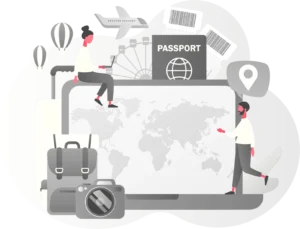Living in a new country is an adventure that comes with excitement and challenges. Canada, known for its welcoming, diverse culture, offers many opportunities for those looking to make it their new home. However, you must understand the intricacies of the Canadian immigration process, including crucial information about work permits, permanent residency, and the financial system in Canada. This is a brief guide on how to immigrate to Canada.
Advertisements
(adsbygoogle = window.adsbygoogle || []).push({});Securing a work permit
The Government of Canada offers various paths for skilled workers and foreign nationals to contribute to the Canadian economy. To work in Canada, obtaining a work permit is your first step. It's a common misconception that you can apply for a work permit upon arrival at a border crossing. However, this is not the case; a border services officer from the Canada Border Services Agency (CBSA) will turn you away. Preparation is key.
Employer-specific work permits
These permits are tie your employment to a specific employer, outlining your role, duration, and work location in Canada. Understandably, Canadian companies regularly leverage these types of work permits to attract new talent and fill vacancies.
Open work permits
Offering more flexibility, open work permits allow you to work for any employer, excluding those deemed ineligible by the Canadian authorities.
Express entry and permanent residency
Permanent residency in Canada gives new immigrants access to everything from social services and health care, to the ability to live, work, and study anywhere in Canada. However, it also allows you to sponsor your family members to join you in Canada, and puts you on the path to Canadian citizenship.
The Express Entry system plays a pivotal role in obtaining permanent residency. It is a selective system meticulously designed to assess and invite foreign national candidates based on age, education, work experience, and language proficiency.
How Express Entry works
After creating a profile, your details are scored and ranked in the Express Entry pool. Canadian officials review the pool and each candidate's compliance with the eligibility criteria. High-ranking candidates are then invited to apply for permanent residency. Upon approval and acceptance, you are welcome to move to Canada immediately.
Key Documents
At a minimum, be prepared with your travel documents, birth certificate, proof of funds, and other documents validating your identity and credentials. Accuracy and completeness are crucial. Only potential immigrants with complete applications will be considered.
Advertisements
(adsbygoogle = window.adsbygoogle || []).push({});Innovative paths for tech talent
Canada's federal government recognizes tech talent's critical role in economic growth and has established innovative paths to attract skilled professionals. The Global Talent Stream, part of the Temporary Foreign Worker Program, exemplifies this by offering expedited work permit processing for highly skilled workers in tech. This initiative not only fills immediate labour shortages but also positions Canada as a leader in the tech industry. Notably, Canadian cities, such as Calgary, and being increasingly recognized for their contribution to the global technology sector.
Benefits for professionals in technology-related fields
The benefits for new tech professionals include fast-tracked work permits, collaborative growth opportunities, and access to a thriving tech ecosystem. The benefit for Canada is a strengthened tech sector, increased domestic innovation, and enhanced global competitiveness.
An entrepreneurial journey to Canada

Immigrant entrepreneurship is a driving force in Canada's economic landscape. And the Start-Up Visa Program encourages entrepreneurs to bring their ventures to Canada, offering another way to obtain permanent residency.
| Program feature | Description |
| Eligibility | Entrepreneurs with a qualifying business idea |
| Support | Connection with Canadian business incubators |
| Outcome | Potential for permanent residency and business growth |
Community and business impact
Immigrant entrepreneurs contribute to job creation and bring innovative solutions to market, enriching Canada's diversity and economic resilience. This is what business immigration programs are so important.
Overcoming obstacles
While immigrating to Canada offers numerous opportunities, it also comes with challenges. Recognizing and addressing these early on is crucial for a smooth transition. Obstacles might include the following:
- Credential recognition: Navigating the process to have international qualifications recognized. Immigration officials generally need a certified copy of your credential(s), with a certified translation for each document.
- Employment: Strategies for finding work in one's field, including networking and Canadian work experience programs.
- Language barriers: Learning a new language can be challenging. Canada has two official languages, English and French.
Advertisements
(adsbygoogle = window.adsbygoogle || []).push({});Banking on a brighter future
Your financial well-being is a cornerstone of your new life in Canada. Fortunately, Canada's banking system is robust and newcomer-friendly, offering various services tailored to ease your transition.
Banking for newcomers
Major Canadian banks have special programs for new permanent residents and international students. These programs include waived monthly fees, easy access to credit products, and helpful financial advice to get you started on the right foot. You can even find special discounts when filing your taxes.
Credit building
Starting with a newcomer credit card is a wise step to building your credit history in Canada. Responsible use of credit is a stepping stone to more significant financial opportunities, like home ownership.
Navigating the Canadian financial system

Upon arrival, setting up your financial foundation is essential. Canada's robust financial system offers newcomer-friendly banking options from the “Big 5” banks, including:
- Royal Bank of Canada (RBC)
- Toronto Dominion (TD)
- Scotiabank
- Bank of Montreal (BMO)
- Canadian Imperial Bank of Commerce (CIBC)
Each of these banks has programs that cater to the needs of new permanent residents and international students, providing a smooth entry into the Canadian banking system.
Big 5 incentives for newcomers
The following table is a good reference guide to the newcomer programs offered by the Big 5 banks.
| Bank | Program name | Benefits |
| | Newcomer Advantage | Waived monthly fees for 12 months |
 | New to Canada Banking Package | No monthly fees for the first 12 months; waived international transfer fees |
 | StartRight Program | No monthly fees for 12 months, access to credit products |
 | NewStart Program | No monthly fees, free chequing and savings account, cash bonus up to $400 |
 | Welcome to Canada Banking Package | Waived account fees for up to two years, $400 bonus for new accounts |
Understanding and accessing financial incentives, such as credit cards and mortgages, is vital for new residents. Contrary to some beliefs, newcomers can obtain credit cards to build their credit history in Canada.
Additionally, various mortgage options are available to help newcomers secure their future homes in Canada, highlighting the inclusive approach of the Canadian financial system.
Your first credit card in Canada
For many newcomers, establishing a credit history is a priority. Thankfully, Canadian banks offer credit cards as part of their newcomer packages, with initial limits of up to $5,000.
Mortgages for newcomers

Are you thinking of buying a home in Canada? There are mortgage options specifically designed for newcomers, accommodating different stages of your journey towards permanent residency.
- New to Canada program mortgages: These are available through organizations like the Canada Mortgage and Housing Corporation (CMHC), offering support to those without a long credit history in Canada.
- Standard mortgages: Once you've established a credit history and secured permanent resident status, a standard mortgage becomes accessible, requiring a down payment and proof of income.
The role of community and cultural integration
The successful integration of immigrants into Canadian society is pivotal. Various programs, community services, and government services facilitate this adjustment, offering language courses, employment assistance, and cultural integration activities.
Language training
Many communities offer the immigrant population free programs to improve English or French proficiency.
Cultural integration
You can attend events and workshops celebrating diversity and promoting community understanding.
Enhancing the immigrant experience
These efforts ensure that immigrants can fully participate in Canadian life, contributing to a cohesive and vibrant society.
Advertisements
(adsbygoogle = window.adsbygoogle || []).push({});The impact of immigration on Canadian society
Immigration enriches Canadian society by introducing diverse cultures, languages, and traditions. This diversity is celebrated and seen as a strength contributing to Canada's global identity.
According to Statistics Canada, immigration also accounts for most of Canada's population growth. It is the true “melting pot” of cultures in the modern world. There are various festivals, gatherings, restaurants, and cultural institutions that reflect the rich makeup of Canadian society.
Support systems
Various organizations and government programs exist to help immigrants overcome these challenges, ensuring their talents and skills are effectively integrated into the Canadian workforce.
Sustainability and immigration
Canada's approach to immigration is also framed within its sustainability goals. Attracting talent in sustainable technologies and environmental sciences is vital to advancing these objectives.
Sustainable development
Immigrants with expertise in green technologies contribute to Canada's environmental initiatives. The growth in green sectors opens new job opportunities for Canadians and immigrants alike.
By focusing on sustainability, Canada addresses global environmental challenges and ensures its people's long-term prosperity and well-being.
Building a life in Canada

Settling in Canada involves understanding your legal requirements, such as obtaining the appropriate work permit and applying for permanent residency through the Express Entry system or other immigration programs. Equally important is establishing your financial foundation, which includes opening a bank account, building your credit history, and understanding your options for mortgages and other financial services.
Canada is a country that thrives on its multicultural fabric, offering a supportive and inclusive environment for newcomers. Beyond the practical steps of immigration and financial setup, integrating into the Canadian community involves engaging with social services, exploring educational opportunities, and participating in cultural and community activities.
Remember, resources and support are readily available. No matter what Canadian province you settle in, Canada wants its newcomers to stay. Visit Creditpicks and subscribe to our mailing list for comprehensive guides, financial advice, and more insights on making the most of your new life in Canada. Creditpicks is dedicated to assisting newcomers in understanding and maximizing their economic opportunities in Canada.
Advertisements
(adsbygoogle = window.adsbygoogle || []).push({});



